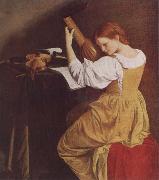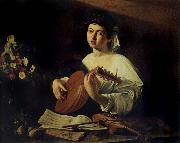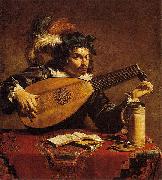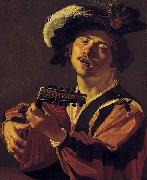Wholesale Oil Painting No Minimum |
|||||||||||
|
|
|||||||||||

|
|||||||||||
|
|
|
||||||||
Orazio Gentileschi1563-1639 Italian Orazio Gentileschi Galleries Tuscan painter, b. Pisa. His real surname was Lomi, but he adopted his uncle name. He studied in Rome, where he was associated with Agostino Tassi in the decoration of palace interiors. Influenced by Caravaggio, Gentileschi developed a more softly luminous light and a cooler, more lyrical style. He also painted frescoes in Santa Maria Maggiore and in the Lateran. After spending several years in Genoa and in France, he settled in England (1626) at the invitation of Charles I. Gentileschi principal works include The Annunciation (San Siro, Genoa); Flight into Egypt (Louvre); Sibyl (Hampton Court, England); and Moses Saved from the Waters (Prado). He also painted numerous portraits. Artemesia Gentileschi was his daughter. |
||||||||
|
|
||||||||
The Lute Player
The Lute Player Painting ID:: 1386 |
1610
The National Gallery of Art, Washington DC 1610 The National Gallery of Art, Washington DC |
|||||||
|
|
||||||||
Orazio Gentileschi1563-1639 Italian Orazio Gentileschi Galleries Tuscan painter, b. Pisa. His real surname was Lomi, but he adopted his uncle name. He studied in Rome, where he was associated with Agostino Tassi in the decoration of palace interiors. Influenced by Caravaggio, Gentileschi developed a more softly luminous light and a cooler, more lyrical style. He also painted frescoes in Santa Maria Maggiore and in the Lateran. After spending several years in Genoa and in France, he settled in England (1626) at the invitation of Charles I. Gentileschi principal works include The Annunciation (San Siro, Genoa); Flight into Egypt (Louvre); Sibyl (Hampton Court, England); and Moses Saved from the Waters (Prado). He also painted numerous portraits. Artemesia Gentileschi was his daughter. |
||||||||
|
|
||||||||
|
|
The Lute Player
The Lute Player Painting ID:: 40429 |
mk156
c.1626
Oil on canvas
144x130cm
mk156 c.1626 Oil on canvas 144x130cm |
||||||
|
|
||||||||
CaravaggioItalian Baroque Era Painter, ca.1571-1610 Italian painter. After an early career as a painter of portraits, still-life and genre scenes he became the most persuasive religious painter of his time. His bold, naturalistic style, which emphasized the common humanity of the apostles and martyrs, flattered the aspirations of the Counter-Reformation Church, while his vivid chiaroscuro enhanced both three-dimensionality and drama, as well as evoking the mystery of the faith. He followed a militantly realist agenda, rejecting both Mannerism and the classicizing naturalism of his main rival, Annibale Carracci. In the first 30 years of the 17th century his naturalistic ambitions and revolutionary artistic procedures attracted a large following from all over Europe. |
||||||||
|
|
||||||||
|
|
The Lute Player
The Lute Player Painting ID:: 41001 |
mk159
c.1595
Oil on canvas
94x119cm
mk159 c.1595 Oil on canvas 94x119cm |
||||||
|
|
||||||||
Theodoor RomboutsFlemish , b. 1597, Antwerpen, d. 1637, Antwerpen was a Flemish Baroque painter specializing in Caravaggesque genre scenes of card players and musicians. He studied under Abraham Janssens in Antwerp and was in Italy between 1616 and 1625, where he was heavily influenced by Caravaggio. |
||||||||
|
|
||||||||
|
|
The Lute Player
The Lute Player Painting ID:: 78634 |
ca. 1620(1620)
Medium Oil on canvas
Dimensions 111 x 98 cm (43.7 x 38.6 in)
cyf ca. 1620(1620) Medium Oil on canvas Dimensions 111 x 98 cm (43.7 x 38.6 in) cyf |
||||||
|
|
||||||||
Dirck van Baburenb.c. 1595, Utrecht, Netherlands. d.Feb. 21, 1624, Utrecht Dutch Dirck van Baburen Gallery |
||||||||
|
|
||||||||
|
|
The Lute player
The Lute player Painting ID:: 85877 |
1622(1622)
Medium Oil on canvas
Dimensions 71.2 x 58.5 cm (28 x 23 in)
cyf 1622(1622) Medium Oil on canvas Dimensions 71.2 x 58.5 cm (28 x 23 in) cyf |
||||||
|
|
||||||||
Willem van Mieris(3 June 1662, Leiden - 26 January 1747, Leiden) was a Dutch painter. He was a son of Frans van Mieris sr. and brother of Jan van Mieris. His works are extremely numerous, being partly imitations of the paternal subjects, or mythological episodes, which Frans habitually avoided. In no case did he come near the excellence of his sire. van Mieris has works in the Victoria and Albert Museum as well as Cheltenham and Derby Museum and Art Gallery |
||||||||
|
|
||||||||
|
|
The Lute Player
The Lute Player Painting ID:: 89269 |
1711(1711)
Medium oil on wood
cyf 1711(1711) Medium oil on wood cyf |
||||||
|
|
||||||||
Gerard ter Borch the Youngerpainted Mother Combing the Hair of Her Child. in 1652 |
||||||||
|
|
||||||||
|
|
The Lute Player
The Lute Player Painting ID:: 95464 |
between 1667(1667) and 1670(1670)
Medium oil on canvas
cyf between 1667(1667) and 1670(1670) Medium oil on canvas cyf |
||||||
|
|
||||||||
|
Gerard ter Borch the Younger painted Mother Combing the Hair of Her Child. in 1652 The Lute Player between 1667(1667) and 1670(1670) Medium oil on canvas cyf |
||||||||
|
|
||||||||
|
Prev Next
|
||||||||
|
|
||||||||
|
Related Paintings to Gerard ter Borch the Younger :. |
||||||||
|
|
||||||||
|
CONTACT US |







